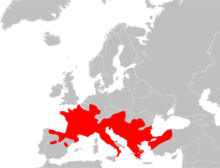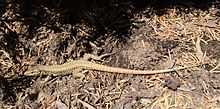Podarcis muralis
| Common wall lizard | |
|---|---|
 | |
| Conservation status | |
| Scientific classification | |
| Kingdom: | Animalia |
| Phylum: | Chordata |
| Class: | Reptilia |
| Order: | Squamata |
| Family: | Lacertidae |
| Genus: | Podarcis |
| Species: | P. muralis |
| Binomial name | |
| Podarcis muralis (Laurenti, 1768) | |
 | |
| Native range of P. muralis in Europe | |
| Synonyms [2] | |
| |
The common wall lizard (Podarcis muralis) is a species of lizard with a large distribution in Europe and well-established introduced populations in North America, where it is also called the European wall lizard. It can grow to about 20 cm (7.9 in) in total length.
Identification
The common wall lizard is a small, thin lizard whose small scales are highly variable in colour and pattern. Its coloration is generally brownish or greyish, and may occasionally be tinged with green. In some individuals, the row of spots along their backs may form a line, while others may have a reticulated pattern with dark spots on the side and scattered white spots that can be blue in the shoulder region. The tail is brown, grey or rust in colour, and may also have light bars on the sides. The belly region has six rows of larger rectangular scales that are generally reddish, pink, or orangish. Common wall lizards may also have dark markings on the throat.
Ecology
The common wall lizard prefers rocky environments, including urban settings, where it can scurry between rock, rubble, debris and buildings.
Distribution and status
The natural range spans mainland Europe, including central Spain, southern Belgium, and the Netherlands. It occurs as introduced populations in southern Britain, and also in North America.
North America
Podarcis muralis has been introduced in the United States of America and is spreading in Northern Kentucky/Cincinnati, Ohio. It is commonly observed living in limestone outcrops, rock walls, and rubble along the Ohio River basin.

It is referred to locally in the Cincinnati/Northern Kentucky area as the "Lazarus lizard",[3] as it was introduced to the area around 1950 by George Rau, a boy who was a member of the family who owned the Lazarus department store chain (now absorbed into Macy's). After he returned from a family vacation to northern Italy, he released about 10 of the reptiles near his Cincinnati home.[4] This prolific lizard has reproduced exponentially; it continues to expand its distribution range annually, and has established itself so well in southwest Ohio, it is now considered a native (although introduced) species by the Ohio Department of Natural Resources and is protected under state law (it is illegal to harm, capture, or possess this animal without a proper licence).[5]
The European wall lizard was also introduced to Vancouver Island, British Columbia, Canada in 1970, when a dozen individuals were released into the wild from a small private zoo.[6]
See also
References
- ↑ Wolfgang Böhme, Valentin Pérez-Mellado, Marc Cheylan, Hans Konrad Nettmann, László Krecsák, Bogoljub Sterijovski, Benedikt Schmidt, Petros Lymberakis, Richard Podloucky, Roberto Sindaco & Aziz Avci (2009). "Podarcis muralis". IUCN Red List of Threatened Species. Version 2011.2. International Union for Conservation of Nature. Retrieved May 9, 2012.
- ↑ P. Uetz (ed.). "Podarcis muralis (Laurenti, 1768)". The Reptile Database. Retrieved May 9, 2012.
- ↑ Dennis, Spencer (May 23, 2011). "Lazarus lizards now part of our culture". Archived from the original on May 26, 2011. Retrieved May 26, 2011.
- ↑ G. Deichsel & D. H. Gist (2001). "On the origin of the common wall lizards Podarcis muralis (Reptilia: Lacertidae) in Cincinnati, Ohio". Herpetological Review 32: 230–232.
- ↑ "Laws: Wild Animal Propagation and Related Activities" (PDF). Division of Wildlife, Ohio Department of Natural Resources. Publication 306 (R304). Retrieved May 9, 2012.
- ↑ G. Deichsel & S. Schweiger (2004). "Geographic distribution: Podarcis muralis". Herpetological Review 35 (3): 289–290.
External links
 Media related to Podarcis muralis at Wikimedia Commons
Media related to Podarcis muralis at Wikimedia Commons Data related to Podarcis muralis at Wikispecies
Data related to Podarcis muralis at Wikispecies- Wall lizard as introduced species in UK
